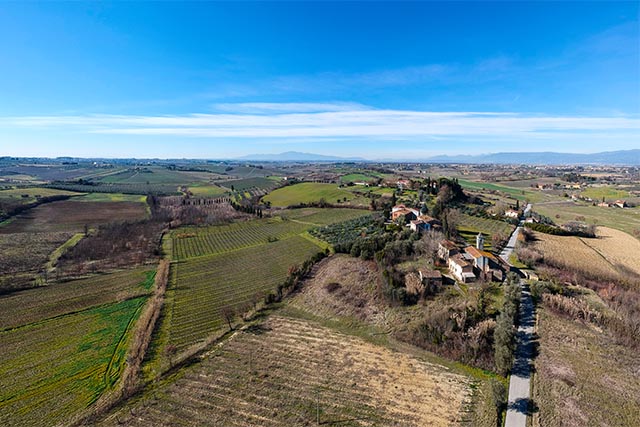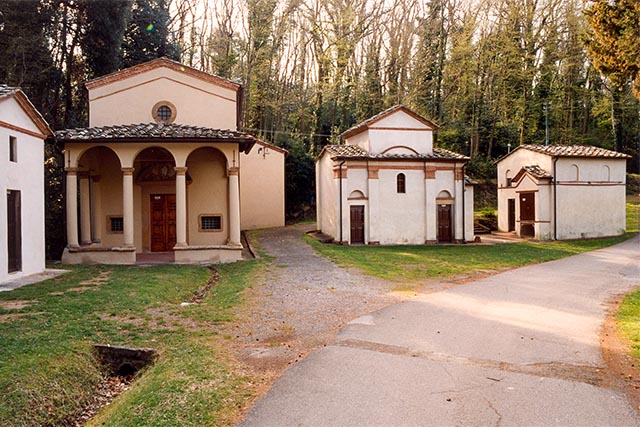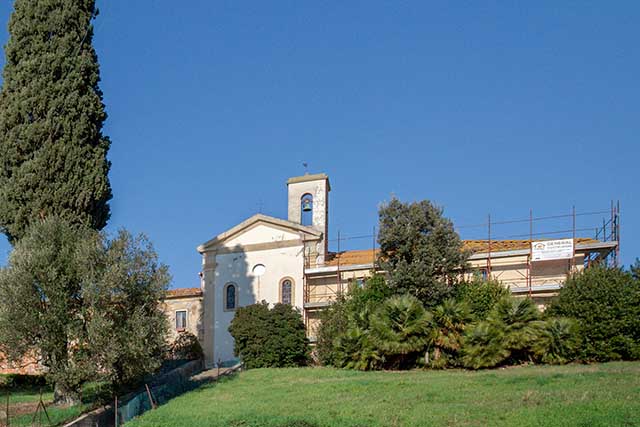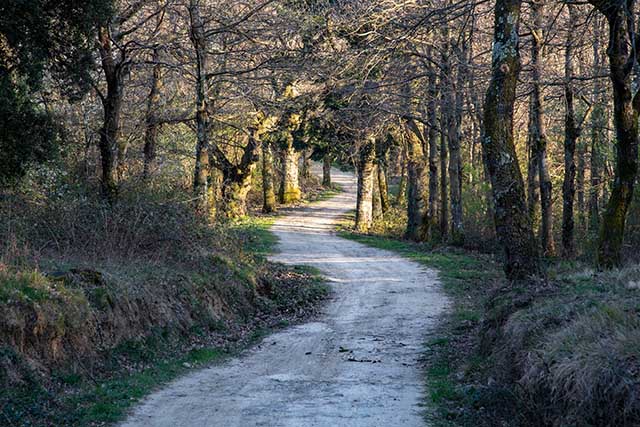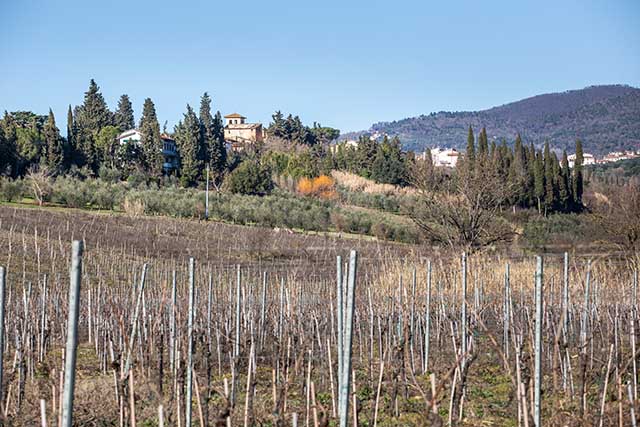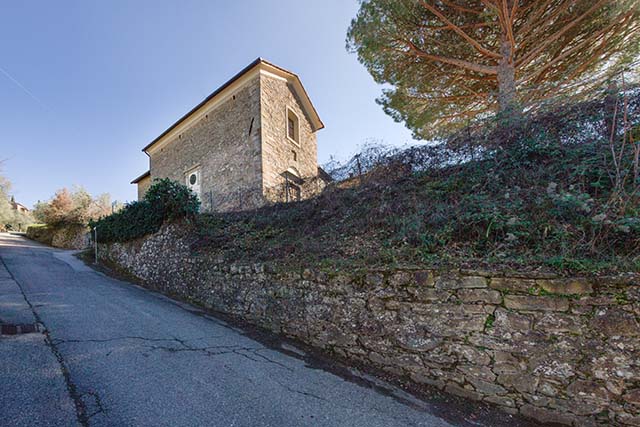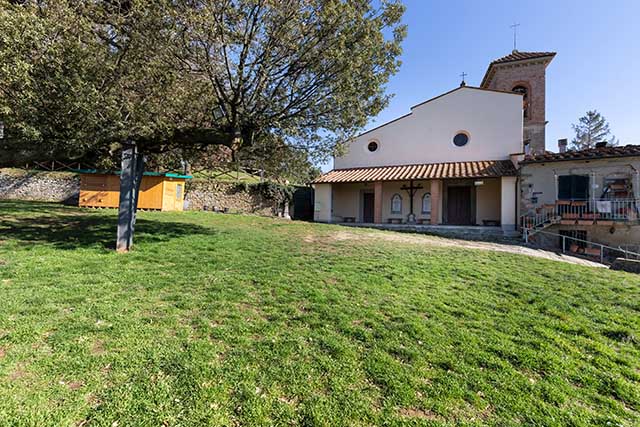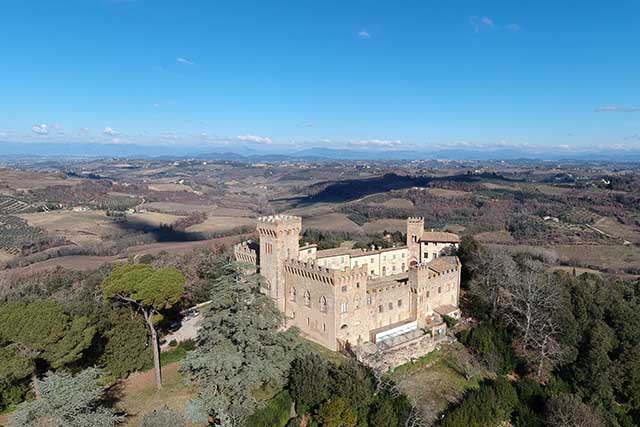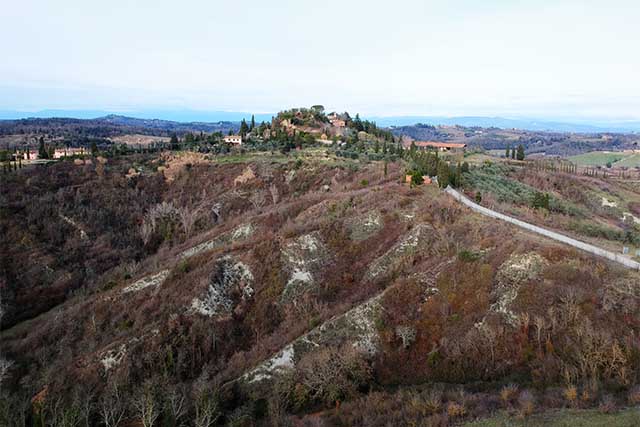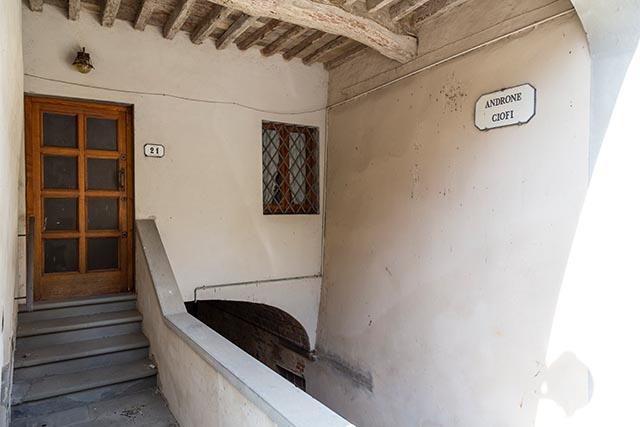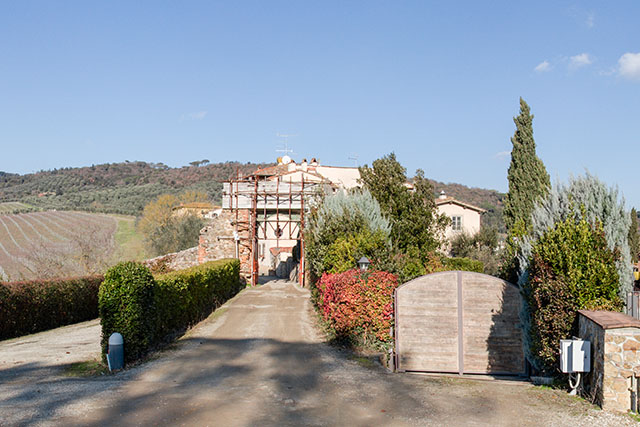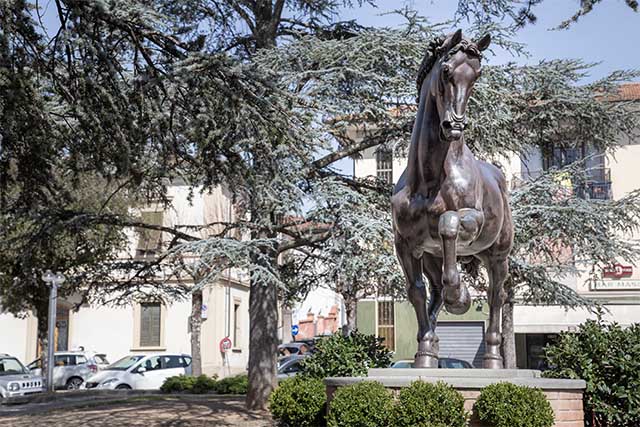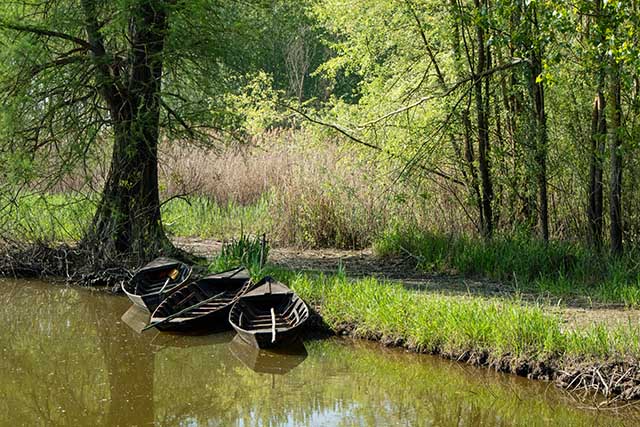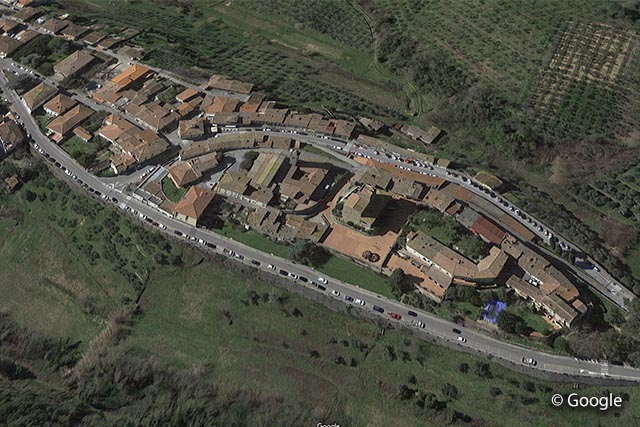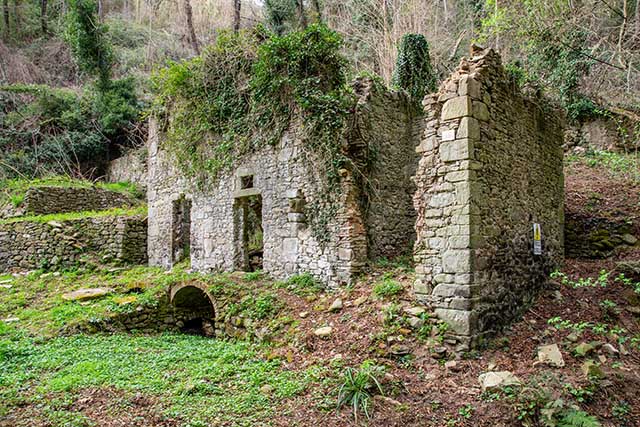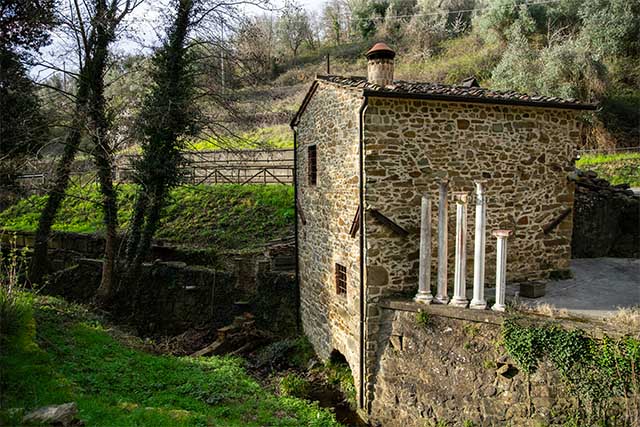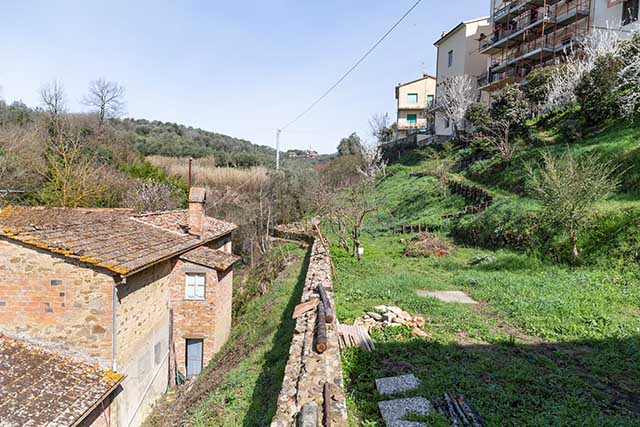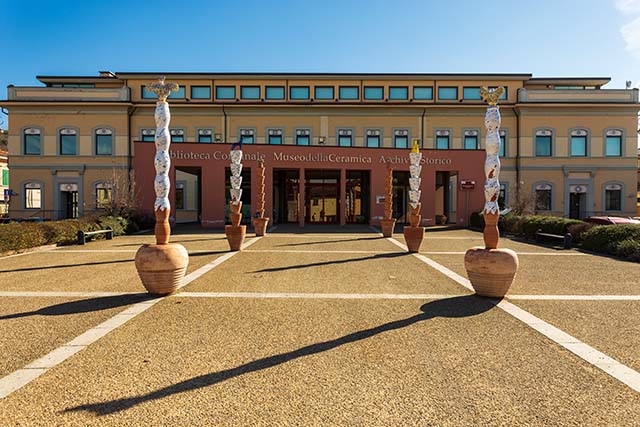Places in the Empolese Valdelsa
Filter/Filtra
At Campo Zeppi, where today there is a group of farmhouses, lived Caterina, Leonardo's mother, together with the family of the man she married, originally from San Pantaleo, known at the time as l’Attaccabriga (the quarrel seeker). These places, very ancient in origin, seem crystallized in the landscape of those times: the church of San Pantaleo was the parish church of Caterina, as well as of the other inhabitants of the houses of Campo Zeppi, and the vineyards are the same ones that Leonardo could see when he went to visit his mother. Among the plots of terrain of the San Pantaleo vineyards, Leonardo could have observed the particular geological formations rich in fossils of marine origin, which he referred to as "nichi” (fossil shells).
On the hills of Montaione lies one of the most beautiful Renaissance sanctuaries in Tuscany. It is the Sacred Mount of San Vivaldo, a complex of chapels that reproduces on a reduced scale the topography of the places related to the life and Passion of Jesus. Among the multimedia resources of the exhibition entitled La costruzione di paesaggi devozionali nell’età di Leonardo (The construction of devotional landscapes in the age of Leonardo), splendid virtual tours will be available through which to experience new itineraries for learning about the Jerusalem of San Vivaldo.
The village of San Zio has ancient origins. The name derives from the saint’s name San Senzio by which the small village was known, depending in the early Middle Ages on the ancient parish church of Cerreto. This small town, located on the hills overlooking Cerreto Guidi, still shows the landscape of the rural countryside that Leonardo must have seen even in his day. On these gentle hills, still rich with vineyards, Leonardo's father declared that he owned houses and plots of land in the towns of a Riminutoli and a Creti. A century later, at the time when the Medici villa of Cerreto was being projected, the lands and farmhouses of San Zio were bought in quantity by the Grand Duke Cosimo I.
The small tower depicted by Leonardo in a central position on Montalbano on the famous map RLW 12685 corresponds, as indicated by the toponym santa lucco, to the so-called Torre di Sant'Alluccio. It was situated, as today, on the ridge of Montalbano, near the road that descended toward Bacchereto from Anchiano. The tower, so familiar to Leonardo, was what remained of an older ecclesiastical complex, but during Leonardo’s time it was already an isolated building, owned by the Florentine family of the Ridolfi. The tower’s history is linked to the events of the ancient Guidi hospital of Sant'Alluccio, the houses of which are perhaps those whose medieval ruins were found in the woods above Sant'Amato.
The rural parish church of Sant'Ansano is one of the topographic landmarks that Leonardo reported, accompanied by the toponym santosano, on the famous bird's eye view map of Montalbano conserved in the Windsor Castle Collection (RLW 12685). The origins of the parish church, one of the oldest in the diocese of Pistoia, date back to the 10th century, but the church that Leonardo viewed must have corresponded roughly to the Romanesque building we can see today, even after the post-World War II restorations. Inside we can admire the series of figured capitals decorating the columns of the central nave and the marble baptismal font attributed to Baccio da Montelupo.
The ancient community of Santa Lucia a Paterno included, during Leonardo’s time, the hamlet of Anchiano, the place where the farm house stands today that tradition recognizes as Leonardo's birthplace. The church of Santa Lucia, which is conserved in 18th-century forms, has absorbed this Leonardian memory from the beginning of the last century, transmitted through a plaque that recalls it as the church where Leonardo was baptized, an event that actually occurred at the church of the Santa Croce in Vinci. However, the church of Paterno was the parish of the family branch of one of Leonardo's half-brothers, Guglielmo di ser Piero da Vinci, who requested, in his will, to be buried in the small church of Santa Lucia.
The church of Santa Maria in Faltognano, on the slopes of Montalbano, once belonged to the castle district of Vinci. The inhabitants of the small groups of houses on these hills, well known by Leonardo, were part of the church of Faltognano. In these areas some of the da Vinci family farms and lands stood. The names of those places, such as La Noce, Il Capannile, and Podere Santa Maria, are well preserved in the current toponymy and can be recognized, among other things, with the same names, in the 16th century maps of the Capitani di Parte Guelfa.
The place where the beautiful castle was built, still dominating the valley of the Virginio in Val di Pesa, has very ancient origins. Of the 12th century castle there remains almost nothing more than the small single-apse church that preserves some interesting architectural details, such as the single-light window in decorated stone. At that time, the castle was controlled by the family of the Counts Alberti. Leonardo depicted Santa Maria Novella at the time when it was used as a country house, but had still kept the characteristics of the early medieval castle. Only in the 19th century was it transformed into the neo-Gothic castle that we see today.
Santo Stefano was depicted by Leonardo as a small turreted castle of the Val d'Egola. Actually, there was already a castle on the site in the 12th century, which belonged, for at least a century before, to the powerful noble family of the Cadolingi. At the threshold of Leonardo’s time, in effect, the castle still seems to have been inhabited, albeit in a phase of depopulation. Today nothing remains of that little village of the Val d'Egola other than the name of the place (the small hamlet of Santo Stefano, in the immediate vicinity of Montaione) and the church of San Bartolomeo, perhaps the ancient castle church mentioned at the end of the 13th century.
During Leonardo’s time, the village tavern stood at the end of Piazza Leonardo da Vinci, strategically positioned between the road to Montalbano and the one that descends, through the narrow vaulted passage of the Androne Ciofi, into the valley of the Vincio, toward the San Pantaleo countryside. Around the 1530s, the tavern was rented to Giovanni, the youngest of Leonardo's half-brothers. The establishment functioned both as a tavern and as a butcher shop, activities requiring a constant use of water. The proximity of the canals that fed the municipality’s mills, positioned next to the tavern-butcher shop, must have been essential, especially for the operation of slaughtering meat.
The Barco Reale, the great Medici hunting reserve, was built in 1626, enclosing the ridge of Montalbano with a long, continuous wall. It did not exist in Leonardo's time, but today some of the surviving features cross through the places he knew well during his youth. Portions of walling can be seen along the Via dei Mulini di Vallebuia and above Bacchereto, in Fornia, the toponym Leonardo indicated in Codex Madrid II. Leonardo also knew well the place enclosed in the small hunting reserve of the Barchetto della Pineta, on Poggio alla Malva, a small promontory over the Arno that Leonardo had drawn on a folio from the Codex Leicester, indicated with the name Pini.
At Piazza della Libertà in Vinci, right nearby the Museo Leonardiano, stands the beautiful bronze sculpture of the horse Leonardo had planned to create to honor the Duke of Milan, Francesco Sforza. His work remained unfinished, but the idea of completing Leonardo's project in the present day became the mission of Charles Dent, an American scholar of the Genius from Vinci, to whom we owe the sculpture of Japanese artist Nina Akamu. The horse is faithful to the original, albeit in smaller dimensions, and stands today as a universal symbol of beauty, of love for Leonardo, and of consideration for his native village.
Leonardo knew the Fucecchio marsh well. From the village of Vinci, passing through San Pantaleo, one arrived in a short time to the shores of the lake. Here stood numerous landings, from where the typical marsh boats carried goods and people from one side to the other over the mirror of water. Leonardo has depicted the Fucecchio Marsh on various maps dedicated to the Lower Valdarno, including map RL 12685 from the Windsor Castle collection. Even in the well renowned Leonardian landscape of 1473 preserved in the Uffizi, it seems we can recognize, in the background, the still waters of the marsh being rippled slightly, perhaps, by a small navicello (marsh ferry).
Vinci was the place of Leonardo's childhood and early youth. Before moving to Florence, he lived with the family of his father, Ser Piero, who worked as a notary, practicing between Florence and Pisa and residing permanently in the city. Thanks to studies by Renzo Cianchi, it is possible to identify today the buildings that once belonged to the da Vinci family. The house where Leonardo lived in his youth was undoubtedly the family’s principal residence, which was situated, then, in the castle village, on the Piazza del Mercatale (market square), overlooking the open space of the minuscule square of today, Piazzetta Guazzesi.
Leonardo must have known well the many mills clustered in his time along the streams descending from the slopes of Montalbano. Today one of the valleys that best represents the mill-working landscape during Leonardo's time is the Forra di Balenaia, also called the Vallebuia, where very well-preserved structures from the 16th and 17th centuries can be found immersed in their suggestive natural environment. Near Vinci, in the 16th century, stood the mill of the Florentine hospital of San Bonifacio, later called the mill of the Burra, now transformed into a dwelling. From this mill, during Leonardo’s time, one could climb up to the Costareccia farm, one of the major properties of his family.
Leonardo must have known well the many mills that dotted the streams of Montalbano that descended toward the castle of Vinci. Rio della Querceta, for example, flowed through the lands of the communities of Faltognano, Paterno, and Santa Croce, where Leonardo’s family owned several farms. Among the mills powered by the waters of Rio della Querceta, there was also the so-called Mulino del Gatto, just above the house at Anchiano, in the place that today bears the same name. The waters of this stream were also used to power the Vinci castle mills, through a weir intake and a conduit hundreds of meters long, still partly visible.
At the edge of the current Piazza Leonardo da Vinci, the ancient platea (courtyard) of the castle village, stood the municipal mill of Vinci. In 1478 Leonardo was called upon by his family to attend the official act of granting the public mill in perpetuity to the da Vinci family, with the proviso of increasing its value through improvements. In fact, this mill is represented in a late 16th-century map, together with a second works, alongside the village osteria and the millrace derived from the waters of Rio della Querceta. Some ruins of the millrace system are still partially visible nearby the ancient ditch used for drainage discharge.
The ceramics museum is today the center of collection and study of the most famous Renaissance majolica of the Florentine area and throughout the Mediterranean basin. At the time of Leonardo, the furnaces of Montelupo had surpassed those of Bacchereto, the oldest production center, which Leonardo knew well, because the family of his paternal grandmother still lived in Bacchereto, making their fortune by means of production of small jugs. The left bank of the Arno, with the Fibbiana clays that Leonardo also observed, provided the raw material for the productions that made Montelupo famous.




